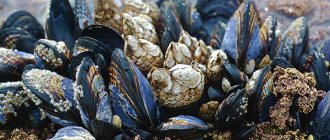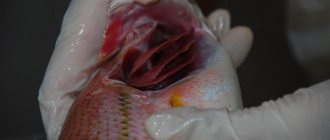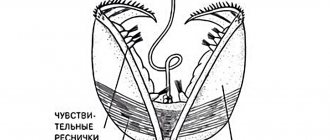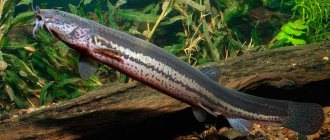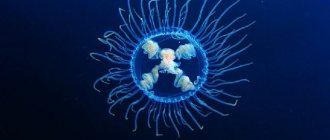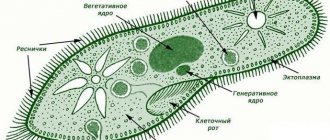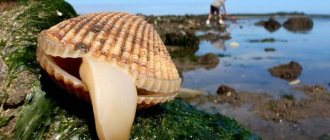Features of the external and internal structure
The vital activity of fish is ensured by the work of not only internal, but also external organs. Before we start talking about digestion, reproduction, oxygen production, it is necessary to study the external structure and understand why they need fins, scales and a lateral line.
External structure of fish
In all fish, the anatomy of the body can be divided into three main parts: head, body, tail. They are crushed into smaller components. So, the head includes:
- Snout (from the tip of the nose to the front edge of the eyes);
- Forehead (between the eyes);
- Cheeks (from the eye to the back of the operculum);
- Throat (between gill membranes and pectoral fins);
- Chin (from the edge of the lower jaw to the base of the gill membranes);
- Interbranch space (forms gill cavities);
After the gill cover, the body begins with dorsal, pectoral, ventral and anal fins. The tail may start from the anal fin or opening.
Proportions play an important role. The variety of body shapes of fish arose from the characteristics of the environment and lifestyle.
| Name | Peculiarities | Advantages |
| Fusiform | The body is streamlined, significantly compressed from the sides, the head tapers towards the end. | The most common type, adapted to life in all water layers, any currents and landscapes. |
| Acne | Elongated and rounded. It often has a small caudal fin and no ventral fin at all. | Fish have a meandering trajectory of movement and live on the bottom or in the near-bottom layer. |
| Ribbon-shaped | Elongated and strongly compressed at the sides. | Comfortable for living in the middle layers of reservoirs. |
| Arrow-shaped | The same height along the entire length, the head and tail resemble the tip of an arrow and its feathers, respectively. | Predators like pike have this shape. Allows you to attack quickly and quickly develop high speed in the middle and upper layers. |
| Torpedo-shaped | The large head extends into a rounded body that tapers to a tail. | Helps you move great distances. |
| Globular | Round body, expanding. | Such fish are inactive and take shape in case of danger. |
| Macroform | The huge head extends into a significantly tapering body and tail. | The proportions are of deep-sea sedentary individuals. |
| Symmetrically compressed laterally | Tall, short, compressed at the sides. | Optimal for life in coral reefs and overgrown reservoirs due to its maneuverability. |
| Asymmetrically compressed laterally | The eyes are on one side. The eyes are located on one side of the body. | It is found in bottom-dwelling, sedentary species. |
Example of an asymmetrical shape: flounder
Skin covering
Fish skin consists of two layers. The upper one - the epidermis - is a tissue with glands that secrete a mucous secretion. It protects the animal's integument and reduces fluid resistance. In the lower layer - the dermis - there are blood vessels, nerves and pigment cells.
The skin of the fish is protected by thin bony scales. This hard cover is formed in dense longitudinal or transverse rows. The plates overlap each other, forming an even denser layer.
The color of the scales may vary. Bright colors warn enemies of danger (for example, the presence of poison in the fish’s body) and camouflage them among corals and algae. Scales of natural or even “camouflage” color cover in freshwater vegetation and muddy water.
The structure of fins and their functions
At the base of the swimming “limbs” of fish are strong bony radials. They are connected by dermal-epidermal tissue, thanks to which the fins perform the function of balance and control.
The paired organs of movement of fish, abdominal and pectoral, located symmetrically on the sides, primarily help to turn and stay in an even position while standing still. Unpaired fins, namely the dorsal and anal, stabilize the body and prevent it from turning around its axis. Most species have two dorsal fins. The main organ of movement - pushing - is the tail and its stem.
In modern fish, fins can play another role in life. For example, in males of viviparous species, the anal fin has evolved into a reproductive organ. Other fish, thanks to their powerful pectoral fins, are able to jump out of the water or rely on them when overcoming a hard surface.
This is interesting: Several species do not have fins, as they spend most of their time buried in the ground.
Side line
From the head of the fish to the base of the caudal fin there is a special sensory organ. The subcutaneous canal, formed by the epithelium and nerve endings, can perceive the lightest vibrations. Its receptors, or neuromasts, have hair cells, and the hairs themselves, no more than 0.2 mm in size, are hidden in cupules - jelly-like caps.
Internal structure of fish
The internal systems of fish are not as complex as, for example, those of most mammals. Moreover, they have unique organs, such as a swim bladder and gills. All this is attached to the fish’s body with the help of muscles and a strong frame, which also cannot be ignored when studying.
Skeleton
The developed muscles of fish rest on the skeleton. Its features allowed scientists to identify three large groups:
- Cyclostomes. They have a serpentine naked body, a cartilaginous skeleton and a skull without jaws. Due to minimal similarity with other representatives, some researchers do not classify cyclostomes as fish at all. These include lampreys and hagfish.
- Cartilaginous. The fish skeleton consists of elastic, dense connective tissue. This group is one of the most ancient. Now it includes sharks and rays.
- Bone. Almost all fish belong to this group.
The fish skeleton is divided into three parts. The axial includes the spine, consisting of the trunk and caudal vertebrae, to which the ribs are attached. The head is a skull formed by a box, jaws, gill covers and arches. Cartilaginous or bone are the basis for all types of fins.
Musculature
The muscle system is divided into smooth and striated tissues. The first form the internal organs of fish, such as the stomach, intestines, blood vessels, and so on. Smooth muscles are able to contract, thereby changing the size of organs. Spindle cells contain myofibrils - protein filaments that give muscles mobility. Striated muscles, regulated by the nervous system, move the fins, head and torso, with the lateral muscle being the largest in the fish's body.
This is interesting: each species has its own muscle color. Trout is known for its pink fabric, sockeye salmon for its bright red color, pike perch for its pale color, and pike for its gray color.
swim bladder
An air sac filled with nitrogen, oxygen and carbon dioxide helps the fish dive and rise to the surface. The fish itself changes its volume, thereby adjusting its position: the smaller the bubble, the deeper it sinks, and vice versa.
Body cavity
The animal's internal organs are located in a special cavity under the spine. They form the main systems involved in the life of fish and their reproduction.
Organ systems
The main issues of vital activity in the body of a fish are solved with the help of six systems: digestive, respiratory, circulatory, excretory, nervous, reproductive, as well as sensory organs, each of which has its own characteristics.
Digestive
It has an elementary structure. Fish do not have a tongue, but they do have cutting devices. Thus, predators have large teeth in several rows, and herbivorous species have small but sharp serrations. The jaw is not adapted for chewing, so food passes through the esophagus into the stomach unprocessed. It quickly dissolves in acid, and the undivided particles enter the small intestine, where they disappear under the influence of bile. The intestinal mucosa absorbs useful microelements, the rest is excreted through the hindgut and opening.
Respiratory
Fish extract oxygen from water using gills. The liquid enters through the mouth into the gill cavity and petals, equipped with capillaries - through which oxygen is absorbed into the body. The remains return to the reservoir through gill slits protected by plates.
Some species have acquired auxiliary organs. So, some get oxygen through the skin or labyrinth - plates in the epibranchial region.
This is interesting: Once out of the water, the fish begin to consume oxygen reserves from the bladder.
Blood
Underwater inhabitants have a simplified, closed circulatory system in one circle. The heart is small, two-chambered. From its ventricle, through the aorta, venous blood enters the artery, which the muscle drives into the gills. Here, during breathing, it turns into an arterial one and passes into the dorsal aorta, further spreading throughout the body of the fish. In addition to oxygen, blood carries useful substances to organs and tissues and takes metabolic waste products from there.
excretory
Along the spine in the lower part of the body there are the main filters - a pair of oval kidneys. Thanks to them, toxins are removed from the fish in the form of urine. From the kidneys, waste fluid enters the bladder through the ureters and then leaves the body through an opening. Another part of the products, more poisonous, exits through the gill filaments.
Nervous and sensory organs
The central nervous system canal runs along the body of the fish and includes the spinal cord and brain. The nerve nodes emanating from them regulate the functioning of organs, glands and blood vessels.
The brain of an underwater animal is divided into five sections:
- Front. Responsible for the sense of smell and communication with relatives.
- Intermediate. Reacts to external influences and sends signals to the right areas of the brain.
- Average. Associated with visual ability.
- Oblong. Gives you the opportunity to hear and touch.
- Cerebellum. Responsible for coordination.
Fish interacts with the external environment using the main sense organs:
- Taste buds. They are found in the oral cavity, as well as in the head, fins, and occasionally on the body itself. This feature is aimed at successful mining.
- Eyes. Since the apple consists of a rounded lens and a flat cornea, the fish sees other organisms and objects only at a distance of approximately 10 meters. However, the eyes can adapt to changes in their environment thanks to rods and cones.
- Organs of hearing. Most species have only an inner ear - a sac with several semicircular canals. Some species have a membranous labyrinth to detect sounds over long distances.
Sexual
Females of bisexual species have ovaries with eggs, fertilization of which occurs either inside her body or already in the water. The males' sperm are stored in their milt, or testes, and are expelled through the anus or a special canal called the gonopodium. Among fish, the phenomenon of hermaphroditism occurs, when one individual has two reproductive systems that alternate in their functions.
General information
Most fish have mouths equipped with many conical teeth designed to capture and hold food. It is not delimited by the pharynx, which leads into the short esophagus. The stomach has a variety of shapes and sizes. Its ability to stretch in deep-sea predatory fish helps them stock up on food.
Partial processing of food in the stomach occurs under the influence of juice produced by small glands of the mucous membrane. Food is completely processed and absorbed in the small intestine. To increase the surface of the digestion, there are blind processes in its upper part. The secretion produced by the pancreas through the ducts flows into the initial section of the intestine. Bile also goes there. Undigested food debris accumulates in the hindgut and is expelled through the anus.
Growth and development of fish
From the moment of fertilization, life appears in the egg. Its development can be divided into six main stages:
- Embryonic. The embryo develops the elementary characteristics of the body. It feeds endogenously on the inner yolk.
- Larval. After hatching, the fish learns to obtain food from the outside, starting with small algae. Internal organs and systems at the initial stage.
- Fry. The fish takes on the external features of an adult fish, differing from it only in size and minor details. The scaly surface of the body begins to form. Separation of the sexes occurs without the development of the reproductive organs themselves.
- Youthful. At this stage, the gonads are already formed, secondary sexual characteristics appear in the form of color and external proportions.
- Adult. The main sign of transition is that the individual is ready to breed offspring.
- Senile. Fish cannot have offspring. The growth of the body slows down or stops completely.
Important: some types of fish, in particular aquarium fish, are viviparous. In this case, formed larvae emerge from the female’s body.
We examined the most obvious signs of the external and internal structure of the fish. Sometimes one species or another has radical and very interesting differences.
Do you know such representatives? Let's remember these unique species and share the features of their structure in the comments.
Digestive tract
In fish, it consists of five sections: the oral cavity, pharynx, esophagus and stomach, which serves for partial digestion of food. In addition, there is an intestine in which the final absorption of food and nutrients occurs and waste is removed through the anus. The quality of nutrition is reflected in the digestive system of fish, and it can vary significantly between different breeds. Largemouth species have a mouth in the form of a special suction funnel, equipped with teeth inside. Fish stick to their prey, drilling into the body with a sharp tongue. They secrete a substance into the wound that partially dissolves the protein. Partially processed food enters the gastrointestinal tract.
Intestines
The esophagus passes into the intestine, which begins with the small intestine. Two ducts flow into it from:
- the liver, which delivers bile;
- pancreas with catalysts (enzymes).
These components contribute to the breakdown of proteins into amino acids, fats into fatty acids and glycerol, and polysaccharides into sugars. After digestion, nutrients are absorbed into the blood through the folded walls of the stomach, equipped with outgrowths and penetrated by lymphatic vessels and capillaries. A feature of the digestive system of fish is the length of the intestines. It is directly dependent on the calorie content of food. In predators it is short, but in fish that feed on plankton it is long. The intestine of the silver carp is 16 times longer than its own size. In all species of fish, it ends with the anus, located between the genital and urinary passages.
Heart rhythm
Contraction of the heart muscle occurs at a certain frequency, the speed of which depends on many factors:
- Biological characteristics of the species;
- Age;
- Health conditions;
- Ambient temperatures;
- Breathing movements;
Thus, in adult carp, the heart rate is on average 20-35 beats per minute, which is quite slow for fish. Especially in comparison with juvenile sturgeon, whose heart rate reaches 150 beats.
The most significant factor is temperature. As soon as the water gets colder, the fish’s heart begins to beat more and more slowly. During hibernation, a bream's heart beats to one beat per minute.
The main task of heart rate is to maintain a certain volume of blood flow corresponding to internal and external circumstances.
Caring for offspring
The spawning of eggs in large quantities is due to the fact that fish do not tend to care about their offspring . The eggs left behind die from enemies, drying out, and unfavorable conditions; only a relatively small part can survive to the stage of a mature individual.
Some fish that care for their young choose spawning sites in crevices, build nests for protection, or carry eggs in their mouths. Thus, a female salmon uses her caudal fin to clear a place for laying eggs, making a depression on the sandy bottom, then covers the eggs with sand (protecting them from predators and freezing).
Parents provide constant access of oxygen to their offspring and use their fins to aerate the water. To prevent the eggs from drying out, the male waters them with water from his mouth. Manifestations of care in fish are at the instinctive level, when the larvae are able to obtain food on their own, can swim well, and their parents leave them.
Please rate the article. We tried our best:)
Electrical properties of the heart
Impulses in the heart muscle do not just happen. It is driven by cardiomyocytes - special organ cells that emit electrical impulses. In structure and functionality they are close to mammalian myocytes.
At rest, cardiomyocytes of teleosts and elasmobranchs are -70 mV, in hagfishes - about -50 mV. At the maximum potential level, the value changes from -50 mV to +15 mV. At the moment of depolarization of the membrane in the body, channels are excited through which sodium and calcium ions penetrate into the cells. At this moment, the heart enters the refractory stage - excitability drops, the state of the cells comes to a neutral level. On average, this phase in fish lasts about 0.15 seconds.
Subsequent membrane repolarization occurs due to the release of potassium ions from the cell. After which the potassium channels close, and the sodium channels do the opposite. So the cardiomyocyte potential returns to -50 mV.
In fish, myocytes are concentrated in specific parts of the heart muscle and together they form the conduction system. As in humans and other mammals, the initiation of systole in fish occurs at the synatrial node. But the function of a pacemaker (sinoatrial node) in fish is performed by all elements of the conduction system: the center of the ear canal and the node in the atrioventricular septum.
Important: the speed of achieving excitation in the cell in fish is lower than in higher animals, and it also varies within the organ of one individual.
Pharynx
From the mouth, food enters the next section of the fish’s digestive system – the pharynx. It contains gill slits that open outward. There are stamens on the gills.
They help predators hold prey and protect the gills from damage. Other fish filter water through the latter and retain food. In addition, there are glands in the pharynx that produce mucus, which facilitates swallowing.
Reproductive system.
Fish are usually dioecious. However, some fish are bisexual. There are cases of transformation of one gender into another. The male gonads are represented by paired testes (milts), which contain a huge number of sperm during the breeding season. From the testes there are ducts that open into the genital opening. The female gonads consist of paired (as an exception, one) ovaries, which pass into short efferent ducts that open into the genital opening. The ovaries contain eggs (eggs). The number of eggs depends both on the age and size of the fish (the older and larger the fish, the more eggs), and on their biological characteristics (as a rule, the less a given type of fish cares about its offspring, the more eggs the females lay).
The eggs are mostly very small, round, rich in yolk. The structure of the egg (ovum) of bony fish is quite complex. The egg is covered with two shells: the outer part is gelatinous and sticky; the inner thick shell sometimes consists of two layers - a denser and a less dense shell. The shells have an opening - a micropyle, through which sperm penetrate into the egg. In addition to the two shells, there is a germinal disk consisting of protoplasm with a nucleus. The protein supply is concentrated in the yolk, in a certain place of which there are one or many fat drops. Fertilization in the vast majority of fish occurs outside the body, in water.
The process of fertilization is that sperm penetrate into the egg through the micropyle, the nucleus of the egg merges with the nucleus of the sperm and fragmentation begins, leading to the development of the embryo. The embryo develops on the nutritious yolk and gradually grows over it; part of the yolk remains as reserve material in the form of a yolk sac in the larva. Since fertilization usually occurs outside the mother's body, the physical and chemical properties of water play a very important role.
Circulatory system.
Immediately behind the gills, on the ventral side of the body, fish have a heart consisting of one atrium and one ventricle; in front of the ventricle there is an elastic expansion (aortic bulb). Valves are located between the atrium and the ventricle and between the ventricle and the aortic bulb.
Blood from the heart enters the abdominal aorta, located under the gills. Four pairs of gill arteries depart from the aorta, which rise to the gill filaments, where they branch into capillaries. Here the blood is enriched with oxygen and carbon dioxide is released. Oxidized blood collects in two aortic roots lying above the gills on the right and left. In front of them the carotid arteries depart, behind both roots of the aorta merge into the aorta; all venous blood collects in the veins, and then flows through the ducts of Cuvier into the venous sinus, from where it enters the heart. Part of the venous blood passes through the liver, part through the kidneys.
The excretory system of fish is represented by two kidneys located on the sides of the spine on the dorsal side of the body cavity. The ureters stretch along the kidneys, which at the posterior end merge into one duct, which opens into the urinary opening on the urogenital papilla.
Oral cavity
The mouth, part of the digestive system, in predator fish is a grasping tool with sharp teeth, which are often arranged in several rows and firmly hold the prey.
Teeth do not have roots and do not last long, and then new ones grow. They can be located not only on the jaw, but also in other places in the oral cavity, including on the tongue. Predators have sharp teeth that are curved back; they are even in the throat. And many peaceful breeds have no teeth at all.
